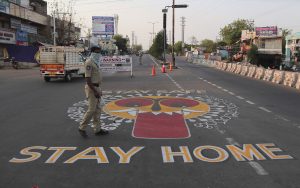When Prime Minister Narendra Modi first announced India’s stringent anti-COVID-19 lockdown in March, he likened it to a wartime effort. Weeks later, it turns out that he was right. India is beginning to discover that lockdowns are much like wars: easy to get into, but difficult to get out of.
After much debate and discussion, the Modi government has now extended India’s lockdown for a second time, albeit slightly watered down. Despite economic suffering, it seemed the inevitable choice. Over the past weeks, chief ministers across the country had been weary of reopening the economy due to unknown consequences. The lockdown has managed to keep cases and fatalities relatively low. But India’s curve is still climbing and nobody knows if an outbreak is waiting to happen. Once the economy is opened, it would be difficult to win back support for yet another lockdown.
This is not to mention the long-term consequences of a botched reopening: If India was to shut down yet again somewhere down the line, it would take much more effort to reassure investors of stability when it was time to reopen again. There would also be consequences for foreign trade, investment, and migration into and out of India. Any chances of an economic recovery – for both the middle class and the poor migrant workers – would be devastated.
Not unlike during wars, therefore, India now needs a clearly articulated long-term exit strategy, including means to comprehensively identify clusters and treat the vulnerable.
So far, India has not done too badly on absolute terms: India is now among the few countries to have completed over 1 million COVID-19 tests at about 75,000 tests a day. But the problem is one of scale. India has so far managed to test about 760 samples per million people – far behind South Korea’s 12,000 and Germany’s 30,000. In states such as Bihar and West Bengal, the number is under 250 per million, which virologists say is nowhere near enough to understand the trend of the virus. At present, these efforts are largely monopolized by the government – and in many parts of India, the government simply does not have the administrative capacity to scale up.
There are also complications of mistrust. In recent weeks, there have been multiple instances of people attacking healthcare workers, owing to stigmatization. Hindu-Muslim tensions also continue to mount. In one case, a local legislator was found asking people not to buy vegetables from Muslim vendors.
The problem for India is that these challenges will continue to persist, even if a vaccine is developed. Pharmaceuticals are one of India’s strengths; a handful of Indian firms are already at the frontlines of the world’s efforts to find a vaccine. And once found, Indian industry has sufficient capacity to mass-produce the vaccine quickly, as one of the world’s top exporters. But for India to vaccinate enough people is a steep ask, given limited administrative reach and capacity, and the apparent lack of trust at the grassroots.
But India has lessons from its own past achievements. In the fight against polio, India was one of the last nations left, owing to many of the same risk factors that make it vulnerable in the COVID-19 world: dense population, poor sanitation, and limited administrative capacity. The task had been daunting; experts said that India needed to achieve 95 percent vaccination coverage in order to prevail. Yet by 2011, India became polio-free, in what Bill Gates called “the most impressive global health success” he’d ever seen. What worked?
In 2013, Gates – who was closely associated with the effort – documented the success story in a Wall Street Journal essay. The anti-polio campaign “enlisted the support of the full sweep of Indian society,” he wrote. In addition to a well-articulated government ad campaign, India saw the participation of the private sector, NGOs and foreign benefactors. Most importantly, the government engaged with local community leaders, especially in slums, in order to win the trust and support of the local inhabitants and to build awareness among them on best practices. In one Kolkata slum, Gates wrote, a group of local schoolchildren dealt with the absence of house numbers by using GPS technology to create a digital map, marking houses where children had not been vaccinated. In all, India mobilized over 2 million vaccinators to go from hamlet to village to slum.
In the effort to reopen against COVID-19, India will need to create a similar blueprint. The confidence of the economy post the lockdown will depend on how comprehensively India is able to test and identify clusters – and how much capacity it can build in order to treat and vaccinate the vulnerable. That will require broader engagement with local community leaders, the private sector and foreign partners. India needs to rediscover its social cohesion.

































